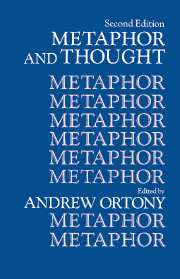Book contents
- Frontmatter
- Contents
- List of contributors
- Preface to the second edition
- Preface to the first edition
- 1 Metaphor, language, and thought
- METAPHOR AND MEANING
- METAPHOR AND REPRESENTATION
- 9 Generative metaphor: A perspective on problem-setting in social policy
- 10 The conduit metaphor: A case of frame conflict in our language about language
- 11 The contemporary theory of metaphor
- 12 Process and products in making sense of tropes
- 13 Metaphor, induction, and social policy: The convergence of macroscopic and microscopic views
- METAPHOR AND UNDERSTANDING
- METAPHOR AND SCIENCE
- METAPHOR AND EDUCATION
- References
- Author index
- Subject index
12 - Process and products in making sense of tropes
Published online by Cambridge University Press: 05 June 2012
- Frontmatter
- Contents
- List of contributors
- Preface to the second edition
- Preface to the first edition
- 1 Metaphor, language, and thought
- METAPHOR AND MEANING
- METAPHOR AND REPRESENTATION
- 9 Generative metaphor: A perspective on problem-setting in social policy
- 10 The conduit metaphor: A case of frame conflict in our language about language
- 11 The contemporary theory of metaphor
- 12 Process and products in making sense of tropes
- 13 Metaphor, induction, and social policy: The convergence of macroscopic and microscopic views
- METAPHOR AND UNDERSTANDING
- METAPHOR AND SCIENCE
- METAPHOR AND EDUCATION
- References
- Author index
- Subject index
Summary
Introduction
The study of tropes, or figures of thought and speech, has always been at the heart of scholarly interest in literature and rhetoric. Because figures twist the “proper” meanings of words – the Greek word for figure is trope meaning “turn, twist” – rhetoricians have closely analyzed the bewildering array of “turns and twists” used in poetry and literature and have provided a sometimes confusing list of labels for these poetic devices (metaphor, metonymy, irony, oxymoron, hyperbole, litotes, periphrasis, antithesis, and so on). Although the history of tropology, dating back to Plato's famous quarrel between philosophy and poetry, reveals tremendous skepticism about the cognitive value of tropes in philosophy and science, there has in recent years been a marked reaffirmation of the ubiquity of tropes in every intellectual discipline concerned with mind and meaning. The first edition of this collection brought to center stage many of the important ideas about figuration in linguistics, philosophy, psychology, science, and education. As befitting its title, the emphasis in that volume was on metaphor (and simile) in both its linguistic and conceptual guises. Very little discussion was devoted to tropes other than metaphor, which is understandable given the prominence of metaphor in intellectual thought starting with Aristotle over two thousand years ago.
Various scholars throughout history, however, beginning with Quintilian, Ramus, and Vico, have argued that a great deal of our conceptualization of experience, even the foundation of human consciousness, is based on figurative schemes of thought which include not only metaphor, but also metonymy, synecdoche, and irony.
- Type
- Chapter
- Information
- Metaphor and Thought , pp. 252 - 276Publisher: Cambridge University PressPrint publication year: 1993
- 50
- Cited by



